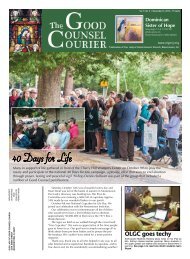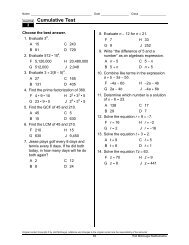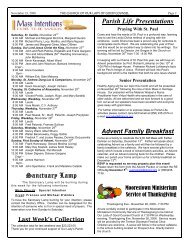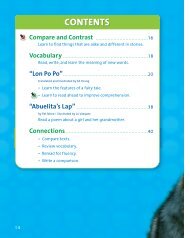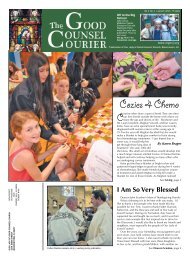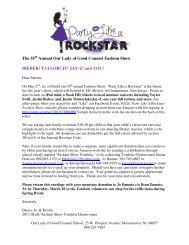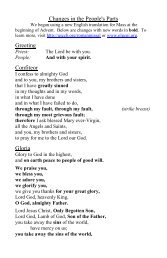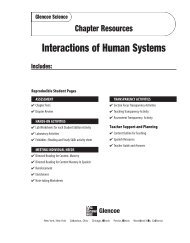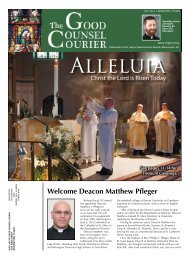Chapter 6 Resource: Ecosystems
Chapter 6 Resource: Ecosystems
Chapter 6 Resource: Ecosystems
Create successful ePaper yourself
Turn your PDF publications into a flip-book with our unique Google optimized e-Paper software.
Glencoe Science<br />
<strong>Chapter</strong> <strong>Resource</strong>s<br />
<strong>Ecosystems</strong><br />
Includes:<br />
Reproducible Student Pages<br />
ASSESSMENT<br />
✔ <strong>Chapter</strong> Tests<br />
✔ <strong>Chapter</strong> Review<br />
HANDS-ON ACTIVITIES<br />
✔ Lab Worksheets for each Student Edition Activity<br />
✔ Laboratory Activities<br />
✔ Foldables–Reading and Study Skills activity sheet<br />
MEETING INDIVIDUAL NEEDS<br />
✔ Directed Reading for Content Mastery<br />
✔ Directed Reading for Content Mastery in Spanish<br />
✔ Reinforcement<br />
✔ Enrichment<br />
✔ Note-taking Worksheets<br />
TRANSPARENCY ACTIVITIES<br />
✔ Section Focus Transparency Activities<br />
✔ Teaching Transparency Activity<br />
✔ Assessment Transparency Activity<br />
Teacher Support and Planning<br />
✔ Content Outline for Teaching<br />
✔ Spanish <strong>Resource</strong>s<br />
✔ Teacher Guide and Answers
Glencoe Science<br />
Photo Credits<br />
Section Focus Transparency 1: (t) SuperStock, (b) Bob Krist/CORBIS;<br />
Section Focus Transparency 2: Chuck Hanson; Section Focus Transparency 3: David Muench/CORBIS<br />
Copyright © by The McGraw-Hill Companies, Inc. All rights reserved.<br />
Permission is granted to reproduce the material contained herein on the condition<br />
that such material be reproduced only for classroom use; be provided to students,<br />
teachers, and families without charge; and be used solely in conjunction with the<br />
<strong>Ecosystems</strong> program. Any other reproduction, for use or sale, is prohibited without<br />
prior written permission of the publisher.<br />
Send all inquiries to:<br />
Glencoe/McGraw-Hill<br />
8787 Orion Place<br />
Columbus, OH 43240-4027<br />
ISBN 0-07-867116-7<br />
Printed in the United States of America.<br />
1 2 3 4 5 6 7 8 9 10 024 09 08 07 06 05 04
Reproducible<br />
Student Pages<br />
Reproducible Student Pages<br />
■ Hands-On Activities<br />
MiniLAB: Try at Home Modeling Rain Forest Leaves . . . . . . . . . . . . . 3<br />
MiniLAB: Modeling Freshwater Environments . . . . . . . . . . . . . . . . . . . 4<br />
Lab: Studying a Land Ecosystem . . . . . . . . . . . . . . . . . . . . . . . . . . . . . . 5<br />
Lab: Use the Internet Exploring Wetlands . . . . . . . . . . . . . . . . . . . . . . 7<br />
Laboratory Activity 1: Succession Communities and Grasses . . . . . . . . 9<br />
Laboratory Activity 2: Exploring Life in Pond Water . . . . . . . . . . . . . 11<br />
Foldables: Reading and Study Skills. . . . . . . . . . . . . . . . . . . . . . . . . . 15<br />
■ Meeting Individual Needs<br />
Extension and Intervention<br />
Directed Reading for Content Mastery . . . . . . . . . . . . . . . . . . . . . . . 17<br />
Directed Reading for Content Mastery in Spanish . . . . . . . . . . . . . . 21<br />
Reinforcement . . . . . . . . . . . . . . . . . . . . . . . . . . . . . . . . . . . . . . . . . . 25<br />
Enrichment. . . . . . . . . . . . . . . . . . . . . . . . . . . . . . . . . . . . . . . . . . . . . 28<br />
Note-taking Worksheet . . . . . . . . . . . . . . . . . . . . . . . . . . . . . . . . . . . 31<br />
■ Assessment<br />
<strong>Chapter</strong> Review . . . . . . . . . . . . . . . . . . . . . . . . . . . . . . . . . . . . . . . . . 35<br />
<strong>Chapter</strong> Test . . . . . . . . . . . . . . . . . . . . . . . . . . . . . . . . . . . . . . . . . . . . 37<br />
■ Transparency Activities<br />
Section Focus Transparency Activities . . . . . . . . . . . . . . . . . . . . . . . . 42<br />
Teaching Transparency Activity . . . . . . . . . . . . . . . . . . . . . . . . . . . . . 45<br />
Assessment Transparency Activity . . . . . . . . . . . . . . . . . . . . . . . . . . . 47<br />
<strong>Ecosystems</strong> 1
Hands-On Activities<br />
Hands-On<br />
Activities<br />
2 <strong>Ecosystems</strong>
Name Date Class<br />
Modeling Rain Forest Leaves<br />
Procedure<br />
1. Draw an oval leaf about 10 cm long on a piece of poster board. Cut it out.<br />
2. Draw a second leaf the same size but make one end pointed. This is called a<br />
drip tip. Cut this leaf out.<br />
3. Hold your hands palm-side up over a sink and have someone lay a leaf on<br />
each one. Point the drip tip away from you. Tilt your hands down but do<br />
not allow the leaves to fall off.<br />
4. Have someone gently spray water on the leaves and observe what happens.<br />
Analysis<br />
1. From which leaf does water drain faster?<br />
Hands-On Activities<br />
2. Infer why it is an advantage for a leaf to get rid of water quickly in a rain forest.<br />
Copyright © Glencoe/McGraw-Hill, a division of the McGraw-Hill Companies, Inc.<br />
<strong>Ecosystems</strong> 3
Name Date Class<br />
Hands-On Activities<br />
Modeling Freshwater Environments<br />
Procedure<br />
1. Obtain a sample of pond sediment or debris, plants, water, and organisms<br />
from your teacher.<br />
2. Cover the bottom of a clear-plastic container with about 2 cm of the<br />
debris.<br />
3. Add one or two plants to the container.<br />
4. Carefully pour pond water into the container until it is about two-thirds full.<br />
5. Use a net to add several organisms to the water. Seal the container.<br />
6. Using a magnifying lens, observe as many organisms as possible. Record<br />
your observations. Return your sample to its original habitat.<br />
Data and Observations<br />
Organism<br />
Observations<br />
Analysis<br />
Write a short paragraph describing the organisms in your sample. How did the organisms interact<br />
with each other?<br />
Copyright © Glencoe/McGraw-Hill, a division of the McGraw-Hill Companies, Inc.<br />
4 <strong>Ecosystems</strong>
Name Date Class<br />
Studying a Land Ecosystem<br />
Lab Preview<br />
Directions: Answer these questions before you begin the Lab.<br />
1. Why do you use the thermometer in this lab?<br />
Hands-On Activities<br />
2. Why is it important to make the same measurements each time you visit your study area?<br />
An ecological study includes observation and analysis of organisms and the<br />
physical features of the environment.<br />
Copyright © Glencoe/McGraw-Hill, a division of the McGraw-Hill Companies, Inc.<br />
Real-World Question<br />
How do you study an ecosystem?<br />
Materials<br />
graph paper tape measure pencil<br />
notebook binoculars magnifying lens<br />
compass thermometer field guides<br />
Goals<br />
■ Observe biotic factors and abiotic factors of an ecosystem.<br />
■ Analyze the relationships among organisms and their environments.<br />
Safety Precautions<br />
Procedure<br />
1. Choose a portion of an ecosystem to study.<br />
You might choose a decaying log, a pond, a<br />
garden, or even a crack in the sidewalk.<br />
2. Determine the boundaries of your study area.<br />
3. Using a tape measure and graph paper,<br />
make a map of your area. Determine<br />
north.<br />
4. Record your observations in Table 1 in the<br />
Data and Observations section.<br />
5. Observe the organisms in your study area.<br />
Use field guides to identify them. Use a<br />
magnifying lens to study small organisms<br />
and binoculars to study animals you can’t<br />
get near. Look for evidence (such as tracks<br />
or feathers) of organisms you do not see.<br />
6. Measure and record the air temperature in<br />
your study area.<br />
7. Visit your study area many times and at<br />
different times of day for one week. At each<br />
visit, make the same measurements and<br />
record all observations. Note how the living<br />
and nonliving parts of the ecosystem<br />
interact.<br />
<strong>Ecosystems</strong> 5
Name Date Class<br />
(continued)<br />
Hands-On Activities<br />
Data and Observations<br />
Table 1 Environmental Observations<br />
Date<br />
Time of day<br />
Temperature<br />
Organisms<br />
observed<br />
Comments<br />
Conclude and Apply<br />
1. Predict what might happen if one or more abiotic factors were changed suddenly.<br />
2. Infer what might happen if one or more populations of plants or animals were removed from<br />
the area.<br />
3. Form a hypothesis to explain how a new population of organisms might affect your ecosystem.<br />
Communicating Your Data<br />
Copyright © Glencoe/McGraw-Hill, a division of the McGraw-Hill Companies, Inc.<br />
Make a classroom display of all data recorded. For more help, refer to the Science Skill<br />
Handbook.<br />
6 <strong>Ecosystems</strong>
Name Date Class<br />
Use the Internet<br />
Exploring Wetlands<br />
Wetlands are an important part of the environment. These fertile ecosystems<br />
support unique plants and animals that can survive only in wetland conditions.<br />
The more you understand the importance of wetlands, the more you<br />
can do to preserve and protect them.<br />
Hands-On Activities<br />
Copyright © Glencoe/McGraw-Hill, a division of the McGraw-Hill Companies, Inc.<br />
Real-World Question<br />
Why are wetlands an important part of the<br />
ecosystem?<br />
Goals<br />
■ Identify wetland regions in the United<br />
States.<br />
■ Describe the significance of the wetland<br />
ecosystem.<br />
■ Identify plant and animal species native<br />
to a wetland region.<br />
■ Identify strategies for supporting the<br />
preservation of wetlands.<br />
Data Source<br />
Visit msscience.com for<br />
Web links for more information<br />
about wetland environments and for<br />
data collected by other students.<br />
Make a Plan<br />
1. Determine where some major wetlands are<br />
located in the United States.<br />
2. Identify one wetland area to study in<br />
depth. Where is it located? Is it classified as<br />
a marsh, bog, or something else?<br />
3. Explain the role this ecosystem plays in the<br />
overall ecology of the area.<br />
4. Research information about the plants<br />
and animals that live in the wetland environment<br />
you are researching.<br />
5. Investigate what laws protect the wetland<br />
you are studying.<br />
Follow Your Plan<br />
1. Make sure your teacher approves your plan<br />
before you start.<br />
2. Perform the investigation.<br />
3. Post your data at the link shown on the<br />
next page.<br />
Analyze Your Data<br />
1. Describe the wetland area you have researched. What region of the United States is it located<br />
in? What other ecological factors are found in that region?<br />
2. Outline the laws protecting the wetland you are investigating. How long have the laws been in<br />
place?<br />
<strong>Ecosystems</strong> 7
Name Date Class<br />
(continued)<br />
Hands-On Activities<br />
3. List the plants and animals native to the wetland area you are researching. Are those plants and<br />
animals found in other parts of the region or the United States? What adaptations do the plants<br />
and animals have that help them survive in a wetland environment?<br />
Conclude and Apply<br />
1. Infer Are all wetlands the same?<br />
2. Determine what the ecological significance of the wetland area that you studied for that region of<br />
the country is.<br />
3. Draw Conclusions Why should wetland environments be protected?<br />
4. Summarize what people can do to support the continued preservation of wetland environments<br />
in the United States.<br />
Communicating Your Data<br />
Find this lab using the link below. Post your data in the table provided. Review other students’<br />
data to learn about other wetland environments in the United States.<br />
Copyright © Glencoe/McGraw-Hill, a division of the McGraw-Hill Companies, Inc.<br />
msscience.com<br />
8 <strong>Ecosystems</strong>
Name Date Class<br />
Copyright © Glencoe/McGraw-Hill, a division of the McGraw-Hill Companies, Inc.<br />
1<br />
Laboratory<br />
Activity<br />
Succession Communities and<br />
Grasses<br />
Once lichens and other pioneer species die and organic matter is added to the soil, other plants<br />
are able to grow. Grasses are a characteristic species of primary and secondary succession. They<br />
are tough and adaptable, grow quickly and readily, and further enrich the soil when they die.<br />
Strategy<br />
You will observe the effect of sunlight and water on the growth of grass.<br />
You will identify differences between the characteristics of a succession community and the<br />
characteristics of a climax community.<br />
Materials<br />
four small plastic pots filled with soil and planted with grass seed<br />
permanent marker<br />
small box open only at one end<br />
water<br />
Procedure<br />
1. Label the pots 1, 2, 3, and 4.<br />
2. Place pot 1 in a location that will receive a<br />
lot of indirect sunlight.<br />
3. Cover pot 2 with the box. Place it next to<br />
pot 1.<br />
4. Water pots 1 and 2 with the same amount<br />
of water twice a week. Keep the soil moist<br />
but not wet.<br />
5. Place pots 3 and 4 in the same location as<br />
plants 1 and 2.<br />
6. Water pot 3 daily. Keep the soil wet.<br />
Data and Observations<br />
Plants 1 and 2 (light)<br />
Plants 1, 3 and 4 (water)<br />
Hypothesis<br />
Observations<br />
7. Do not water pot 4.<br />
8. In the Data and Observations table, write a<br />
hypothesis describing how you think the<br />
amount of light will affect pots 1 and 2.<br />
Write another hypothesis describing how<br />
you think the amount of water will affect<br />
pots 1, 3, and 4.<br />
9. Care for the plants daily for three weeks.<br />
Record observations at the end of each<br />
week.<br />
Plant Week 1 Week 2 Week 3<br />
1<br />
2<br />
3<br />
4<br />
Hands-On Activities<br />
<strong>Ecosystems</strong> 9
Name Date Class<br />
Laboratory Activity 1 (continued)<br />
Hands-On Activities<br />
Questions and Conclusions<br />
1. What was the effect of the amount of light on pots 1 and 2? How does your hypothesis differ<br />
from the results?<br />
2. What was the effect of the amount of water on pots 1, 3, and 4? How does your hypothesis<br />
differ from the results?<br />
3. What characteristics of grass do you think make it well-suited as a late primary or secondary<br />
succession plant?<br />
4. Would you find grasses in a climax community? Why or why not?<br />
Strategy Check<br />
Can you observe the effect of sunlight and water on the growth of grass?<br />
Can you identify differences between the characteristics of succession and climax<br />
communities?<br />
Copyright © Glencoe/McGraw-Hill, a division of the McGraw-Hill Companies, Inc.<br />
10 <strong>Ecosystems</strong>
Name Date Class<br />
Copyright © Glencoe/McGraw-Hill, a division of the McGraw-Hill Companies, Inc.<br />
2<br />
Laboratory<br />
Activity<br />
Exploring Life in Pond Water<br />
Looking through a microscope, you can see a miniature world of many, many microorganisms.<br />
In a single drop of pond water, you might be able to see protists, bacteria, plants, and tiny<br />
animals. Because the ecosystem of a pond is not uniform throughout, different organisms live in<br />
different parts of the pond. Water collected from the surface and from near the sediment will<br />
contain some of the same organisms, but there will be some organisms that live in only one area<br />
or the other.<br />
Strategy<br />
You will examine two samples of pond water under the microscope.<br />
You will identify some of the organisms that exist in each sample of pond water.<br />
You will compare the organisms found near the surface to those found near the bottom of the pond.<br />
Materials<br />
water collected from the surface of a pond<br />
droppers (2)<br />
microscope slides (2)<br />
coverslips (2)<br />
microscope<br />
water collected near the bottom of a pond<br />
Procedure<br />
1. Use the dropper to place one drop of surface<br />
pond water on a clean microscope slide.<br />
Carefully put the coverslip on the drop.<br />
2. Examine the surface pond water under low<br />
and high power magnification of the<br />
microscope. Carefully move the slide so<br />
that you are able to examine all areas of the<br />
slide.<br />
3. Use the drawings in the Data and Observations<br />
section to identify the organisms you<br />
observe. On the lines under the drawings,<br />
indicate which organisms were observed in<br />
the surface pond water.<br />
4. Repeat steps 1 through 3 for a drop of<br />
water from the bottom of the pond.<br />
5. Complete Table 1 in the Data and Observations<br />
section by entering the microorganisms<br />
that you observe in the water from the<br />
surface and the bottom of the pond.<br />
6. Enter your data in the table your teacher<br />
has prepared on the board by putting a<br />
mark by each organism that you observed<br />
in your samples. When all students have<br />
entered their data, complete Table 2 by<br />
summarizing the data from the table on<br />
the board.<br />
Hands-On Activities<br />
<strong>Ecosystems</strong> 11
Name Date Class<br />
Laboratory Activity 2 (continued)<br />
Hands-On Activities<br />
Data and Observations<br />
1. Oscillatoria 2. Paramecium 3. Vorticella<br />
____________________ ____________________ ____________________<br />
4. Daphnia (waterflea) 5. Euglena 6. Amoeba<br />
____________________ ____________________ ____________________<br />
7. Rotifers 8. Nematodes 9. Cyclops<br />
____________________ ____________________ ____________________<br />
10. Diatoms 11. Volvox 12. Desmids<br />
Copyright © Glencoe/McGraw-Hill, a division of the McGraw-Hill Companies, Inc.<br />
____________________ ____________________ ____________________<br />
12 <strong>Ecosystems</strong>
Name Date Class<br />
Laboratory Activity 2 (continued)<br />
Table 1<br />
Individual Data<br />
Organisms found in surface pond water Organisms found near pond bottom<br />
Hands-On Activities<br />
Table 2<br />
Group Data<br />
Organism Near surface Near bottom<br />
Oscillatoria<br />
Paramecium<br />
Vorticella<br />
Copyright © Glencoe/McGraw-Hill, a division of the McGraw-Hill Companies, Inc.<br />
Daphnia<br />
Euglena<br />
Amoeba<br />
Rotifers<br />
Nematodes<br />
Cyclops<br />
Diatoms<br />
Volvox<br />
Desmids<br />
<strong>Ecosystems</strong> 13
Name Date Class<br />
Laboratory Activity 2 (continued)<br />
Hands-On Activities<br />
Questions and Conclusions<br />
1. Did you find different organisms in the surface and deep pond water samples? Explain.<br />
2. What factors might influence why some organisms are found only in surface pond water or<br />
only in deep pond water?<br />
3. Because a pond is an ecosystem that changes all the time, experimental variables might have an<br />
impact on your observations. Explain how each of the following might influence the organisms<br />
observed:<br />
a. season of the year<br />
b. delay between when the sample was collected and the experiment was performed<br />
c. depth of collection site for water from the bottom of the pond<br />
d. distance from shore that the surface water was collected<br />
4. In what ways might human activity impact the pond water ecosystem?<br />
Strategy Check<br />
Can you examine samples of pond water under the microscope?<br />
Can you identify the organisms that exist in each sample of pond water?<br />
Can you compare the organisms found on the surface of a pond to those found near the<br />
bottom?<br />
Copyright © Glencoe/McGraw-Hill, a division of the McGraw-Hill Companies, Inc.<br />
14 <strong>Ecosystems</strong>
Name Date Class<br />
<strong>Ecosystems</strong><br />
Directions: Use this page to label your Foldable at the beginning of the chapter.<br />
occurs where no soil exists<br />
begins in a place that has<br />
soil and was once home<br />
to living things<br />
Hands-On Activities<br />
a community that has<br />
reached the final stage of<br />
ecological succession<br />
a community that has<br />
reached the final stage<br />
of ecological succession<br />
Primary<br />
Succession<br />
Copyright © Glencoe/McGraw-Hill, a division of the McGraw-Hill Companies, Inc.<br />
Secondary<br />
Succession<br />
Climax<br />
Communities<br />
Climax<br />
Communities<br />
<strong>Ecosystems</strong> 15
Meeting Individual Needs<br />
Meeting<br />
Individual Needs<br />
16 <strong>Ecosystems</strong>
Name Date Class<br />
Directed Reading for<br />
Content Mastery<br />
Overview<br />
<strong>Ecosystems</strong><br />
Directions: Complete the concept map using the terms below.<br />
cold forest region tundra deserts grassland<br />
Major<br />
biomes<br />
include<br />
include<br />
include<br />
include<br />
1.<br />
that is a<br />
cold, dry,<br />
treeless region<br />
taiga<br />
that is a<br />
4.<br />
2.<br />
that are<br />
the driest<br />
biomes on<br />
Earth<br />
3.<br />
such as the<br />
prairies of<br />
North America<br />
Meeting Individual Needs<br />
Copyright © Glencoe/McGraw-Hill, a division of the McGraw-Hill Companies, Inc.<br />
Directions: In the spaces provided, indicate whether each ecosystem is saltwater, freshwater, or both.<br />
5. coral reefs<br />
6. estuaries<br />
7. rivers and streams<br />
8. open oceans<br />
9. lakes and ponds<br />
10. wetlands<br />
<strong>Ecosystems</strong> 17
Name Date Class<br />
Directed Reading for<br />
Content Mastery<br />
Section 1 ■ How <strong>Ecosystems</strong><br />
Change<br />
Meeting Individual Needs<br />
Directions: Complete the following sentences using the terms listed below. Some terms may be used more than once.<br />
primary secondary succession pioneer climax<br />
1. The gradual change from one community of organisms to another is<br />
ecological ____________________.<br />
2. Succession that takes place in a forest that has been destroyed by fire is an<br />
example of ____________________ succession.<br />
3. The first organisms to move into a disturbed environment are the<br />
____________________ species.<br />
4. A community that tends to remain the same and is in the final stage of<br />
succession is a ____________________ community.<br />
5. Ecological succession that takes place in a location that does not have<br />
soil is ____________________ succession.<br />
6. A beech-maple forest is an example of a ____________________ community.<br />
7. When no life exists at all in an area, ____________________ succession begins.<br />
8. Physical disturbances such as fires disturb the stability of<br />
a ____________________ community.<br />
9. ____________________ succession can take hundreds or even thousands of<br />
years to develop into a climax community.<br />
10. Number the following sentences describing primary succession so that they are<br />
in the correct order.<br />
a. Mosses and ferns grow in soil formed by decaying lichens.<br />
b. Thicker, richer soil supports the growth of shrubs and trees. Insects,<br />
small birds, and mammals move in.<br />
c. Eventually, the soil layer thickens and grasses, wildflowers, and other<br />
plants begin to take over.<br />
d. Life on a bare rock begins as lichens and the forces of weather and<br />
erosion help break down rocks into smaller pieces to form soil.<br />
Copyright © Glencoe/McGraw-Hill, a division of the McGraw-Hill Companies, Inc.<br />
18 <strong>Ecosystems</strong>
Name Date Class<br />
Directed Reading for<br />
Content Mastery<br />
Section 2 ■ Biomes<br />
Section 3 ■ Aquatic <strong>Ecosystems</strong><br />
Directions: Use the following terms to identify the biome in which you would expect to find each animal listed below.<br />
tundra grassland temperate rain forest<br />
taiga temperate deciduous forest desert<br />
1. salamanders<br />
2. caribou<br />
Copyright © Glencoe/McGraw-Hill, a division of the McGraw-Hill Companies, Inc.<br />
3. oak tree<br />
4. zebra<br />
5. moose<br />
6. kangaroo rat<br />
Directions: Match the words and phrases in Column II with the descriptions in Column I. Write the letter of the<br />
correct word or phrase in the blank at the left.<br />
Column I<br />
Column II<br />
7. organisms that float near the surface a. intertidal zones<br />
of freshwater lakes and ponds<br />
8. extremely fertile, productive<br />
environments that serve as<br />
important nurseries for many<br />
ocean fish<br />
9. home to organisms adapted to<br />
dramatic changes in temperature,<br />
moisture, and salinity<br />
10. flowing freshwater environments<br />
11. usually covered with a thin sandy, or gravelly<br />
soil that contains little organic matter<br />
12. located in New Zealand, southern Chile, and<br />
the Pacific Northwest of the United States<br />
13. large geographic areas that have similar<br />
climates and ecosystems<br />
b. temperate rain forests<br />
c. rivers and streams<br />
d. biomes<br />
e. algae, plants, and plankton<br />
f. estuaries<br />
g. deserts<br />
Meeting Individual Needs<br />
<strong>Ecosystems</strong> 19
Name Date Class<br />
Directed Reading for<br />
Content Mastery<br />
Key Terms<br />
<strong>Ecosystems</strong><br />
Directions: Use the clues to complete the crossword puzzle.<br />
1<br />
2<br />
3<br />
4<br />
5<br />
6<br />
7<br />
Meeting Individual Needs<br />
9<br />
8<br />
11<br />
12<br />
10<br />
13<br />
Across<br />
1. The first living things in a disturbed<br />
environment, such as lichens<br />
3. Forests with warm temperatures,<br />
wet weather, and lush plant growth<br />
5. Region that is wet for all or most of<br />
a year<br />
9. A community that has reached a<br />
stable stage of ecological succession<br />
11. Climax communities dominated<br />
by grasses<br />
12. A cold, dry, treeless region, sometimes<br />
called a cold desert<br />
13. Water ecosystem formed from the<br />
calcium carbonate shells secreted by<br />
a particular animal<br />
20 <strong>Ecosystems</strong><br />
Down<br />
2. The portion of the shoreline that is<br />
covered with water at high tide and<br />
exposed to the air during low tide<br />
4. The normal, gradual changes that<br />
occur in the types of species that<br />
live in an area<br />
6. Forests dominated by trees with<br />
needlelike leaves<br />
7. Large geographic areas that have<br />
similar climates and ecosystems<br />
8. A cold forest region dominated by<br />
cone-bearing evergreen trees.<br />
10. The area where a river meets an ocean<br />
and contains a mixture of freshwater<br />
and saltwater<br />
Copyright © Glencoe/McGraw-Hill, a division of the McGraw-Hill Companies, Inc.
Nombre Fecha Clase<br />
Lectura dirigida para<br />
Dominio del contenido<br />
Sinopsis<br />
Ecosistemas<br />
Instrucciones: Completa el mapa de conceptos usando los siguientes términos.<br />
región boscosa fría tundra desiertos praderas<br />
Los principales<br />
biomas<br />
Copyright © Glencoe/McGraw-Hill, a division of the McGraw-Hill Companies, Inc.<br />
1.<br />
que es<br />
una región fría<br />
seca y sin<br />
árboles<br />
incluyen<br />
incluyen<br />
la taiga<br />
que es<br />
4.<br />
incluyen<br />
2.<br />
que son<br />
los biomas<br />
más secos<br />
de la Tierra<br />
incluyen<br />
3.<br />
como<br />
las praderas de<br />
América del Norte<br />
Instrucciones: Indica en los espacios si cada ecosistema es de agua salada, agua fresca, o ambos.<br />
5. arrecifes de coral<br />
6. estuarios<br />
7. ríos y corrientes<br />
8. océanos abiertos<br />
9. lagos y charcas<br />
10. tierras pantanosas<br />
Satisface las necesidades individuales<br />
Ecosistemas 21
Satisface las necesidades individuales<br />
Nombre Fecha Clase<br />
Sección 1 ■ Cómo cambian<br />
los ecosistemas<br />
Instrucciones: Completa las oraciones con los siguientes términos. Puedes usar los términos más de una vez.<br />
primaria secundaria sucesión pioneras clímax<br />
1. El cambio gradual de una comunidad de organismos a otra se llama _______.<br />
2. La sucesión que ocurre en un bosque arrasado por el fuego es un ejemplo de<br />
sucesión ____________.<br />
3. Los primeros organismos que llegan para ocupar un ambiente alterado se llaman<br />
especies ____________.<br />
4. Una comunidad que tiende a permanecer igual y que está en la etapa final de la<br />
sucesión es una comunidad en ________.<br />
5. La sucesión ecológica que ocurre en un sitio que no tiene suelo es una sucesión<br />
_____________.<br />
6. Un bosque de hayas y arces es un ejemplo de una comunidad en ____________.<br />
7. Cuando no existe vida en un área, comienza la sucesión ___________.<br />
8. Las alteraciones físicas, como los incendios, afectan la estabilidad del (de la)<br />
________.<br />
9. La sucesión _______________puede tomar cientos o miles de años para desarrollarse<br />
como una comunidad en clímax.<br />
10. Ordena correctamente las siguientes oraciones que describen la sucesión primaria.<br />
______a.<br />
______b.<br />
______c.<br />
______d.<br />
Lectura dirigida para<br />
Dominio del contenido<br />
Los musgos y los helechos crecen en el suelo formado por los líquenes<br />
en descomposición.<br />
Un suelo más rico y grueso sustenta el crecimiento de arbustos y<br />
árboles. Insectos, aves y mamíferos pequeños se mudan al sitio.<br />
A la postre, la capa del suelo se hace más gruesa, y las flores silvestres y<br />
otras plantas comienzan a dominar el área.<br />
La vida sobre la roca desnuda comienza con líquenes y las fuerzas del<br />
clima y la erosión ayudan a desintegrar las rocas para formar suelo.<br />
Copyright © Glencoe/McGraw-Hill, a division of the McGraw-Hill Companies, Inc.<br />
22 Ecosistemas
Copyright © Glencoe/McGraw-Hill, a division of the McGraw-Hill Companies, Inc.<br />
Nombre Fecha Clase<br />
Instrucciones: Usa los siguientes términos para identificar el bioma en el cual esperarías encontrar cada uno de los<br />
animales en la lista.<br />
tundra pradera bosque pluvial templado<br />
taiga bosque deciduo de zona templada desierto<br />
1. salamandra<br />
2. caribú<br />
3. roble<br />
4. cebra<br />
5. alce<br />
6. rata canguro<br />
Lectura dirigida para<br />
Dominio del contenido<br />
Instrucciones: Coordina la frase o palabra de la Columna II con las descripciones de la Columna I. Escribe la<br />
letra de la palabra o letra correcta en el espacio de la izquierda.<br />
Columna I<br />
Columna II<br />
7. organismos que flotan cerca de la<br />
superficie de los estanques y lagos<br />
8. ambientes extremadamente fértiles y<br />
productivos que sirven como criaderos<br />
importantes para muchos peces marinos.<br />
9. hogar de organismos adaptados a<br />
cambios dramáticos en temperatura,<br />
humedad y salinidad.<br />
10. ambientes de agua en movimiento<br />
11. generalmente cubiertos por una capa<br />
delgada arenosa o pedregosa de suelo<br />
que contiene poca materia orgánica<br />
Sección 2 ■ Biomas<br />
Sección 3 ■ Ecosistemas<br />
acuáticos<br />
a. zonas intermareales<br />
b. bosques pluviales de zona<br />
templada<br />
c. ríos y corrientes<br />
d. biomas<br />
e. algas, plantas y plancton<br />
f. estuarios<br />
g. desiertos<br />
12. localizado en Nueva Zelanda, el sur de Chile y el noroeste del<br />
pacífico de Estados Unidos.<br />
13. grandes áreas geográficas que tienen el mismo clima y ecosistemas<br />
Satisface las necesidades individuales<br />
Ecosistemas 23
Nombre Fecha Clase<br />
Lectura dirigida para<br />
Dominio del contenido<br />
Términos claves<br />
Ecosistemas<br />
Instrucciones: Usa las claves para completar el crucigrama.<br />
1<br />
2<br />
3<br />
4<br />
5<br />
Satisface las necesidades individuales<br />
6<br />
10<br />
7<br />
8<br />
11<br />
9<br />
Horizontales<br />
3. Tipo de bosque dominado por<br />
árboles con hojas como agujas.<br />
5. Comunidad que ha alcanzado una<br />
etapa estable de la sucesión ecológica.<br />
6. Comunidad clímax dominada por<br />
pastos.<br />
7. Ecosistema formado por las conchas<br />
de carbonato de calcio que secreta<br />
un animal particular.<br />
8. Región muy húmeda durante todo o<br />
gran parte del año.<br />
10. Bosques de temperaturas cálidas, clima<br />
húmedo y vegetación exuberante.<br />
11. Parte del litoral cubierta de agua<br />
durante la marea alta y expuesta<br />
durante la marea baja.<br />
Verticales<br />
1. Región fría, seca y sin árboles, a<br />
veces llamada desierto helado.<br />
2. Cambios normales graduales que<br />
ocurren en los tipos de especies que<br />
viven en un área.<br />
4. Área en donde un río se encuentra con<br />
el océano y que tiene una mezcla de<br />
agua dulce y salada.<br />
5. Especies que colonizan en la sucesión<br />
primaria, como por ejemplo,<br />
los líquenes.<br />
8. Región fría dominada por árboles<br />
siempreverdes portadores de conos.<br />
9. Área geográfica grande con climas y<br />
ecosistemas similares.<br />
Copyright © Glencoe/McGraw-Hill, a division of the McGraw-Hill Companies, Inc.<br />
24 Ecosistemas
Name Date Class<br />
1<br />
Reinforcement<br />
How <strong>Ecosystems</strong> Change<br />
Directions: What kind of ecological succession occurs after each of the following events? Write either primary<br />
succession or secondary succession under each diagram.<br />
1. _________________________________ 2. _________________________________<br />
Meeting Individual Needs<br />
Copyright © Glencoe/McGraw-Hill, a division of the McGraw-Hill Companies, Inc.<br />
3. _________________________________ 4. _________________________________<br />
Directions: Answer the following questions on the lines provided.<br />
5. What is ecological succession?<br />
6. What is the general name for the first species to grow after a volcanic eruption covers an area<br />
with lava?<br />
7. How does soil form from bare rock?<br />
8. How does succession occur after a forest fire?<br />
9. Which takes longer, primary succession or secondary succession? Explain.<br />
10. What is a community that has reached a stable stage of ecological succession called?<br />
<strong>Ecosystems</strong> 25
Name Date Class<br />
2<br />
Reinforcement<br />
Biomes<br />
Directions: Complete the table below using information in your textbook.<br />
Biome<br />
Climate<br />
Dominant plants<br />
Characteristic<br />
animals<br />
Meeting Individual Needs<br />
1. Tundra<br />
2. Taiga<br />
3. Temperate<br />
deciduous<br />
forest<br />
4. Temperate<br />
rain forest<br />
5. Tropical<br />
rain<br />
forest<br />
6. Desert<br />
7. Grassland<br />
Copyright © Glencoe/McGraw-Hill, a division of the McGraw-Hill Companies, Inc.<br />
26 <strong>Ecosystems</strong>
Name Date Class<br />
3<br />
Reinforcement<br />
Aquatic <strong>Ecosystems</strong><br />
Directions: Describe two life zones in the ocean and how organisms are affected by the conditions in each zone.<br />
1.<br />
2.<br />
Copyright © Glencoe/McGraw-Hill, a division of the McGraw-Hill Companies, Inc.<br />
Meeting Individual Needs<br />
Directions: Answer the following questions on the lines provided.<br />
3. The illustrations above show two types of freshwater ecosystems. Which supports more<br />
species and why?<br />
4. What is an estuary and why is it important to marine organisms?<br />
5. Why are wetlands protected in most areas?<br />
6. How do coral reefs form? What makes them vulnerable to environmental stress?<br />
<strong>Ecosystems</strong> 27
Name Date Class<br />
1<br />
Enrichment<br />
Succession<br />
The four pictures below show succession in a small area in New York. Think of these pictures as<br />
four photographs, with many years in between. Notice that in each picture, the plants have<br />
changed and so have the animals. Use the pictures to answer the questions below.<br />
Stage 1<br />
grasshopper sparrow<br />
meadowlark<br />
Stage 2<br />
robin<br />
white-tailed deer<br />
Meeting Individual Needs<br />
Stage 3<br />
meadow mouse<br />
junco<br />
rabbit<br />
field sparrow<br />
robin<br />
short-tailed shrew<br />
rabbit<br />
white-footed mouse<br />
Stage 4<br />
red squirrel<br />
veery<br />
red fox<br />
short-tailed shrew<br />
red fox<br />
short-tailed shrew<br />
red squirrel<br />
white-tailed deer<br />
white-footed<br />
mouse<br />
white-footed mouse<br />
red fox<br />
short-tailed shrew<br />
1. In which stage is grass mostly found?<br />
2. The grasshopper sparrow is so named because of what it eats. Why do you think it is mostly<br />
found in Stage 1?<br />
3. What new species appears in Stage 3? What can you hypothesize about this species based on<br />
the four pictures?<br />
4. By Stage 4, what type of vegetation has taken over?<br />
5. How did the trees change the environment, making it less favorable for the grasses to grow?<br />
6. Which animal survived in all stages of this succession? Why?<br />
Copyright © Glencoe/McGraw-Hill, a division of the McGraw-Hill Companies, Inc.<br />
28 <strong>Ecosystems</strong>
Name Date Class<br />
2<br />
Enrichment<br />
Identifying Biomes<br />
Use an atlas to place each of these 12 cities on the world map below. Then compare the map<br />
you have made with the map in your textbook of the world’s major land biomes. In which biome<br />
does each city belong? Look at the information in the textbook about precipitation in each of the<br />
land biomes to help you. Complete the table by identifying the biome each city is in.<br />
City Yearly precipitation (cm) Biome<br />
1. Addis Ababa, Ethiopia<br />
121.2<br />
2. Anchorage, Alaska<br />
3. Antananarivo, Madagascar<br />
4. Beijing, China<br />
5. Buenos Aires, Argentina<br />
6. Frankfurt, Germany<br />
7. Khartoum, Sudan<br />
8. Madrid, Spain<br />
39.9<br />
136.1<br />
63.0<br />
98.0<br />
69.1<br />
15.2<br />
44.7<br />
Meeting Individual Needs<br />
9. Manila, Philippines<br />
10. Phoenix, Arizona<br />
197.4<br />
18.8<br />
Copyright © Glencoe/McGraw-Hill, a division of the McGraw-Hill Companies, Inc.<br />
11. Pretoria, South Africa<br />
12. Sydney, Australia<br />
70.9<br />
113.0<br />
<strong>Ecosystems</strong> 29
Name Date Class<br />
3<br />
Enrichment<br />
The Everglades<br />
Meeting Individual Needs<br />
The Florida Everglades are unique—there is nothing else quite like them in the world. They are<br />
a habitat for a tremendous number of organisms, and they provide a breeding ground for many<br />
more species. Despite their environmental importance, these wetlands have been under attack by<br />
human development for decades. Some scientists are concerned that the Everglades may have<br />
been irreversibly harmed. We might lose these wetlands forever.<br />
Use library resources to write a report on the Everglades. Look in the library’s computer or card<br />
catalog for books on this topic. Check the Readers’ Guide to Periodical Literature or the library’s<br />
computer search system for recent magazine articles on the Everglades. Use at least three books or<br />
articles to write your report. List these sources at the end of your report.<br />
Try to answer these questions in your report:<br />
■ How much area do the Everglades cover?<br />
■ What lake and river system feeds the Everglades?<br />
■ What animals live in the Everglades?<br />
■ What are some animals that use the Everglades as breeding grounds?<br />
■ How much area has the Everglades lost in recent years?<br />
■ What major city has been spreading into the area that once was part of the<br />
Everglades?<br />
■ What has been the role of the Army Corps of Engineers in changing the<br />
environment in the Everglades?<br />
■ How is water that goes into the Everglades controlled?<br />
■ What have environmentalists been saying about the danger of losing the<br />
Everglades?<br />
■ At the end of your report, write a paragraph expressing your own opinions<br />
about the threat to the Everglades and what should be done.<br />
Florida<br />
Everglades National Park<br />
Copyright © Glencoe/McGraw-Hill, a division of the McGraw-Hill Companies, Inc.<br />
30 <strong>Ecosystems</strong>
Name Date Class<br />
Note-taking<br />
Worksheet<br />
<strong>Ecosystems</strong><br />
Section 1<br />
How <strong>Ecosystems</strong> Change<br />
A. Ecological ____________________—normal, gradual changes that occur in the types of<br />
species that live in an area<br />
1. Primary succession begins in a place without ________.<br />
a. Starts with _________________________ such as _________________, that can grow<br />
on rock<br />
b. New ______________ forms as weather and erosion break down rock.<br />
c. Decaying plants add __________________________ to new soil.<br />
2. ______________________________ begins in a place that has soil and once had living<br />
organisms<br />
a. Examples: after a ______________ or removal of buildings<br />
b. Occurs faster and has different pioneer species than primary succession<br />
B. __________________________—stable stage of ecological diversity and balance<br />
Meeting Individual Needs<br />
Section 2<br />
Biomes<br />
Copyright © Glencoe/McGraw-Hill, a division of the McGraw-Hill Companies, Inc.<br />
A. Factors that affect biomes’ climates<br />
1. temperature<br />
2. __________<br />
B. Major ________________—large areas with similar climates and ecosystems<br />
1. ________________—cold, dry, treeless region<br />
a. Permanently frozen soil called ____________________<br />
b. Average winter temperature: _______________<br />
c. Average precipitation is _________________________ 25 cm per year.<br />
d. Plants: ________________, grasses, small shrubs, lichens<br />
e. Animals: insects, ducks, geese, other birds, mice, arctic ______________ , reindeer<br />
2. _______________— cold forest of mostly evergreen trees<br />
a. Soil _______________ in the short summer.<br />
b. Precipitation: mostly snow, _____________________ per year<br />
31
Name Date Class<br />
Note-taking Worksheet (continued)<br />
3. ________________________ forests—region with four seasons, mostly trees that lose their<br />
leaves in autumn<br />
a. Temperatures range from ________________________ in winter to<br />
_______________________ in summer.<br />
b. Precipitation: throughout the year, _____________________ per year<br />
4. ________________________ forest—tall trees with needlelike leaves<br />
a. Average temperature: _____________________<br />
Meeting Individual Needs<br />
b. Precipitation: _____________________ per year<br />
5. ________________________ forests—the most biologically diverse of all biomes<br />
a. Average temperature: _______________<br />
b. Precipitation: ______ per year<br />
c. Four _____________: forest floor, understory, canopy, emergents<br />
d. Human impact: habitats being _____________________ by farmers and loggers<br />
6. ________________—driest biome, supports little plant life<br />
a. Temperatures: vary from _____________ to ______________<br />
b. Precipitation: less than ______ cm per year<br />
c. Soil: thin, _______________, or gravelly<br />
d. Plant: cactus<br />
e. Animal: kangaroo ______<br />
7. ____________________—prairies or plains, dominated by grasses<br />
a. Temperatures: temperate or _______________<br />
b. Precipitation _____________________ per year; dry season<br />
Section 3 Aquatic <strong>Ecosystems</strong><br />
A. ____________________ ecosystems—include flowing and standing water, low or no salt<br />
1. Rivers and streams—_________________ water<br />
a. Most ___________________ washed into water from land.<br />
b. The faster the flow, the greater the ________________ content.<br />
Copyright © Glencoe/McGraw-Hill, a division of the McGraw-Hill Companies, Inc.<br />
32 <strong>Ecosystems</strong>
Name Date Class<br />
Note-taking Worksheet (continued)<br />
2. Lakes and ponds—very little ______________<br />
a. Sunlight warms and lights pond ________________ supporting plant and animal life.<br />
b. Deeper lakes support life along _________________ shoreline or surface<br />
3. Water ___________________—a problem caused by fertilizer-filled runoff and sewage<br />
4. __________________—regions wet all or most of year<br />
a. Lie between __________________ and water<br />
b. Very _________________ ecosystems<br />
Copyright © Glencoe/McGraw-Hill, a division of the McGraw-Hill Companies, Inc.<br />
B. Saltwater ecosystems—95% of Earth’s water contains high concentration of salt, or<br />
high __________________.<br />
1. Open oceans—divided into lighted and dark life _______________<br />
a. _________________—upper 200 m and home of plankton<br />
b. ______________—below 200 m where animals feed on material that floats down or<br />
prey on each other<br />
2. _____________________—diverse and fragile ecosystems formed from coral shells of<br />
calcium carbonate<br />
3. Seashores—along ____________________<br />
a. _________________________—covered with water at high tide and exposed to air at<br />
low tide<br />
b. Drastic _________________ in temperature, moisture, salinity, and wave action<br />
4. ___________________—where a river meets an ocean; called bays, lagoons, harbors, inlets, sounds<br />
a. Rich in ___________________<br />
b. Changing _________________ of salt water and freshwater<br />
Meeting Individual Needs<br />
<strong>Ecosystems</strong> 33
Assessment<br />
Assessment<br />
34 <strong>Ecosystems</strong>
Name Date Class<br />
<strong>Chapter</strong><br />
Review<br />
<strong>Ecosystems</strong><br />
Part A. Vocabulary Review<br />
Directions: Write the correct term in the spaces provided. Unscramble the boxed letters to spell the term that<br />
answers question 14.<br />
1. a community that has reached a stable<br />
stage of ecological succession<br />
2. the normal, gradual changes that occur<br />
in the types of species that live in an<br />
area<br />
1. ___ ___ ___ ___ ___<br />
___ ___ ___ ___ ___ ___ ___ ___ ___<br />
2. ___ ___ ___ ___ ___ ___ ___ ___ ___<br />
3 the portion of the shoreline that is<br />
covered with water at high tide and<br />
exposed to the air during low tide<br />
4. temperate and tropical regions that<br />
receive between 25 cm and 75 cm of<br />
precipitation a year and and have climax<br />
communities of grasses<br />
5. forest with warm temperatures, wet<br />
weather, and lush plant growth<br />
3. ___ ___ ___ ___ ___ ___ ___ ___ ___<br />
___ ___ ___ ___<br />
4. ___ ___ ___ ___ ___ ___ ___ ___ ___<br />
5. ___ ___ ___ ___ ___ ___ ___<br />
___ ___ ___ ___ ___ ___ ___ ___ ___ ___<br />
6. forest dominated by climax<br />
communities of trees that lose their<br />
leaves every autumn<br />
6. ___ ___ ___ ___ ___ ___ ___ ___<br />
___ ___ ___ ___ ___ ___ ___ ___<br />
Copyright © Glencoe/McGraw-Hill, a division of the McGraw-Hill Companies, Inc.<br />
7. large geographic areas that have similar<br />
climates and ecosystems<br />
8. a cold, dry, treeless region, sometimes<br />
called a cold desert<br />
9. a cold forest region dominated by<br />
cone-bearing evergreen trees<br />
10. the driest biome, often covered with a<br />
thin, sandy, or gravelly soil, contains<br />
little organic matter<br />
11. the area where a river meets an ocean<br />
contains both freshwater and salt water<br />
12. regions that are wet for all or most of<br />
a year<br />
13. ecosystems formed from the calcium<br />
carbonate shells secreted by animals<br />
___ ___ ___ ___ ___ ___<br />
7. ___ ___ ___ ___ ___<br />
8. ___ ___ ___ ___ ___<br />
9. ___ ___ ___ ___<br />
10. ___ ___ ___ ___ ___<br />
11. ___ ___ ___ ___ ___ ___<br />
12. ___ ___ ___ ___ ___ ___ ___<br />
13. ___ ___ ___ ___ ___ ___ ___ ___ ___<br />
Assessment<br />
14. The first living things to arrive at a primary succession:<br />
<strong>Ecosystems</strong> 35
Name Date Class<br />
<strong>Chapter</strong> Review (continued)<br />
Assessment<br />
Part B. Concept Review<br />
Directions: For each of the following, write either P for pioneer species or C for climax community in the lines provided.<br />
1. beech-maple forest<br />
2. lichens<br />
3. mosses and ferns<br />
Directions: For each of the following, write either P for primary succession or S for secondary succession in the<br />
lines provided.<br />
4. erupting volcano<br />
5. abandoned paved parking lot<br />
6. wilderness after a forest fire<br />
Directions: Match the location and wildlife with the correct biomes. Biomes may be used more than once.<br />
7. Douglas fir; spruce; black bear; cougar<br />
8. eastern United States; Europe<br />
9. kangaroos; wildebeests; cattle<br />
10. just south of the tundra biome; cone-bearing<br />
evergreen trees; elk<br />
11. near the equator, including in South America<br />
12. white-tailed deer; brightly colored leaves in autumn<br />
13. cactus; scorpions; kangaroo rats<br />
14. snowy owls; reindeer; lichens<br />
15. more biological species than anywhere else in the world<br />
Directions: Answer the following questions on the lines provided.<br />
16. In water environments, what are the most important factors that determine which species<br />
can survive?<br />
17. Name three standing freshwater ecosystems.<br />
18. Why are wetlands important?<br />
a. taiga<br />
b. temperate deciduous<br />
forest<br />
c. desert<br />
d. grassland<br />
e. tropical rain forest<br />
f. tundra<br />
g. temperate rain forest<br />
Copyright © Glencoe/McGraw-Hill, a division of the McGraw-Hill Companies, Inc.<br />
19. What causes tides to rise and fall each day?<br />
36 <strong>Ecosystems</strong>
Transparency<br />
Activities<br />
Transparency Activities<br />
<strong>Ecosystems</strong> 41
Name Date Class<br />
1<br />
Section Focus<br />
Transparency Activity<br />
New Land, New Life<br />
Both photographs below are of Surtsey, an island near Iceland.<br />
Surtsey was created in 1963 by a volcanic eruption. Surtsey provides<br />
a wonderful opportunity for scientists to study how life starts in a<br />
new area.<br />
Transparency Activities<br />
1. Describe what you see in the<br />
first picture. Would you expect<br />
plants or animals to be able to<br />
live there?<br />
2. What evidence of life do you<br />
see in the second picture?<br />
3. How has Surtsey changed? How<br />
might it continue to change?<br />
Copyright © Glencoe/McGraw-Hill, a division of the McGraw-Hill Companies, Inc.<br />
42 <strong>Ecosystems</strong>
Name Date Class<br />
2<br />
Section Focus<br />
Transparency Activity<br />
Sentinel<br />
This unusual tree is a type of quiver tree. This rare species is found<br />
in parts of South Africa and Namibia. This particular type of quiver<br />
tree is critically endangered; estimates show fewer than 200 fullgrown<br />
trees left.<br />
Copyright © Glencoe/McGraw-Hill, a division of the McGraw-Hill Companies, Inc.<br />
1. Describe the characteristics of the quiver tree from the photo.<br />
2. What kind of environment does this tree live in?<br />
3. Hypothesize what factors might threaten the quiver tree.<br />
Transparency Activities<br />
<strong>Ecosystems</strong> 43
Name Date Class<br />
3<br />
Section Focus<br />
Transparency Activity<br />
Is there a Great Happy<br />
Swamp?<br />
Almost three-fourths of Earth’s surface is covered by water. This<br />
water is in the Great Dismal Swamp located in Virginia and North<br />
Carolina.<br />
Transparency Activities<br />
1. Why were wetlands like the Great Dismal Swamp originally<br />
considered dismal and useless places? Why are they valued today?<br />
2. Name some other water systems. How does human activity affect<br />
these systems?<br />
Copyright © Glencoe/McGraw-Hill, a division of the McGraw-Hill Companies, Inc.<br />
44 <strong>Ecosystems</strong>
Name Date Class<br />
2<br />
Teaching Transparency<br />
Activity<br />
Biomes<br />
ASIA<br />
AUSTRALIA<br />
EUROPE<br />
AFRICA<br />
Copyright © Glencoe/McGraw-Hill, a division of the McGraw-Hill Companies, Inc.<br />
NORTH<br />
AMERICA<br />
Tropic of Cancer<br />
Equator<br />
SOUTH<br />
AMERICA<br />
Tropic of Capricorn<br />
Desert<br />
Grassland<br />
Tropical rainforest<br />
Temperate rainforest<br />
Temperate deciduous forest<br />
Taiga<br />
Tundra<br />
Transparency Activities<br />
Arctic Circle<br />
Antarctic Circle<br />
<strong>Ecosystems</strong> 45
Name Date Class<br />
Teaching Transparency Activity (continued)<br />
1. What are similar climates and ecosystems called?<br />
2. What is a climate?<br />
3. What biome covers the majority of Australia?<br />
4. Where are major tropical rain forests located?<br />
5. How many major land biomes are on Earth?<br />
6. Which three biomes can be found in large areas of the United States?<br />
Transparency Activities<br />
Copyright © Glencoe/McGraw-Hill, a division of the McGraw-Hill Companies, Inc.<br />
46 <strong>Ecosystems</strong>
Name Date Class<br />
Assessment<br />
Transparency Activity<br />
<strong>Ecosystems</strong><br />
Directions: Carefully review the diagrams and answer the following questions.<br />
W<br />
X<br />
Grasses and weeds<br />
Y<br />
Large shrubs and<br />
medium-sized trees<br />
Z<br />
Copyright © Glencoe/McGraw-Hill, a division of the McGraw-Hill Companies, Inc.<br />
Shrubs, weeds, and<br />
small tree seedling<br />
Uniform stand of<br />
tall trees<br />
1. What is the correct sequence of these stages of succession?<br />
A X, Y, Z, W B Y, W, Z, X C Z, Y, W, X D W, Y, X, Z<br />
2. At which stage is equilibrium most likely to be restored to the<br />
ecosystem?<br />
F Z G W H X J Y<br />
3. A reasonable hypothesis based on these data would be that ___.<br />
A once trees are established, other species disappear<br />
B shrubs represent a middle stage of succession<br />
C trees cannot grow unless grasses and shrubs grow first<br />
D slower-growing species tend to appear sooner in the process of<br />
succession<br />
Transparency Activities<br />
<strong>Ecosystems</strong> 47



